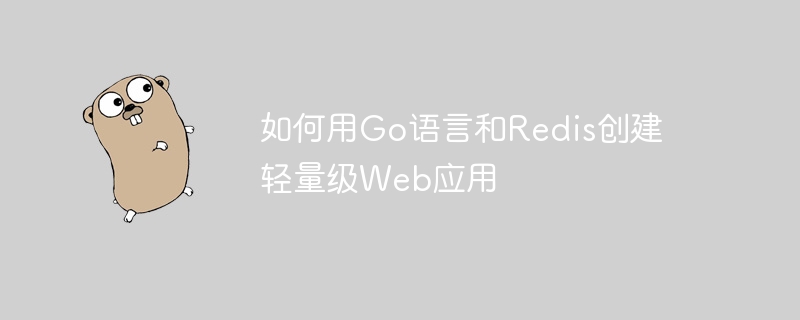Home >Backend Development >Golang >How to create lightweight web applications using Go language and Redis
How to create lightweight web applications using Go language and Redis
- 王林Original
- 2023-10-27 11:13:42885browse

How to create lightweight web applications using Go language and Redis
Overview:
Go language is a fast and efficient programming language, and Redis is An extremely popular in-memory cache database. Combining the two can create lightweight web applications to achieve fast data access and processing. This article will introduce the steps on how to create a lightweight web application using Go language and Redis, and provide specific code examples.
Step 1: Install and configure Go language and Redis
First, you need to ensure that Go language and Redis have been installed and configured correctly. You can download the Go language installation package from the official website and follow the prompts to install and configure it. Similarly, you can also download the Redis installation package from the Redis official website and follow the instructions to install and configure it.
Step 2: Import the dependency packages of Go language and Redis
To use Redis in Go language, you need to import the corresponding dependency packages first. Add the following code at the beginning of the code file:
import (
"github.com/gomodule/redigo/redis"
// 其他依赖包
) Step 3: Connect to the Redis database
Use the following code to connect to the Redis database:
func connectToRedis() (redis.Conn, error) {
conn, err := redis.Dial("tcp", "localhost:6379")
if err != nil {
return nil, err
}
return conn, nil
} Step 4: Define the function to handle the request
Define the function to process the request in the code, for example:
func handleRequest(w http.ResponseWriter, r *http.Request) {
// 处理请求的逻辑
}Step 5: Implement specific business logic
Write specific business logic code according to actual needs. The following is a simple example showing how to create a simple counter using the Go language and Redis:
func incrementCounter() (int, error) {
conn, err := connectToRedis()
if err != nil {
return 0, err
}
defer conn.Close()
count, err := redis.Int(conn.Do("GET", "counter"))
if err != nil {
return 0, err
}
count++
_, err = conn.Do("SET", "counter", count)
if err != nil {
return 0, err
}
return count, nil
}Step 6: Handle HTTP requests
Add the following code to handle HTTP requests:
func main() {
http.HandleFunc("/", handleRequest)
http.ListenAndServe(":8080", nil)
}Step 7: Compile and run the application
Use the following command in the terminal to compile the application:
go build main.go
Then run the application:
./main
In this way, the application will start and listen to the local 8080 port, waiting for the request to arrive.
Conclusion:
This article introduces the steps of how to use Go language and Redis to create lightweight web applications, and provides specific code examples. By combining the Go language and Redis, we can quickly and efficiently build powerful web applications. Of course, this is just a simple example, and it needs to be modified and improved according to needs in actual applications. I hope this article can be helpful to readers and inspire more learning and practice about Go language and Redis.
The above is the detailed content of How to create lightweight web applications using Go language and Redis. For more information, please follow other related articles on the PHP Chinese website!

